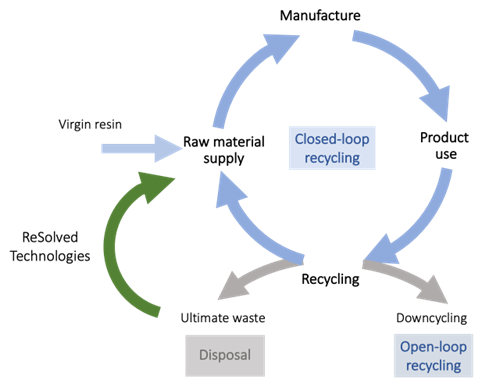Carbon & Circularity Credits derived from recycled (ultimate) plastic waste.
Norbert Fraunholcz
ReSolved Technologies BV
Urmonderbaan 22
6167 RD Geleen, Netherlands
M: +31-(0)6-247 074 83
E: norbert@resolved-tech.com
URL: www.resolved-tech.com
Plastics are one of the largest group of raw materials. In fact, plastics production by volume
outweighs the production of all metals combined. The circularity of raw materials has been in the
spotlights in recent years, as it is one of the main pillars of sustainability together with greenhouse
gas emissions.
Recycling from waste is the most important tool to make raw materials circular. At the same time, the
CO2 emission associated with the production of plastics can be reduced by 50 to 80% through
recycling compared to production from fossil fuels. Given the fact that approx. half of the global CO2
emission is related to the production of raw materials, these savings are significant.
The use of low-emission recycled plastic in new products increases the sustainability performance of
the whole product value chain. Furter, the interdependency between the stakeholders in the value
chain is much stronger in a circular economy than in a linear one. Yet, contributing to the transition is
not always easy for companies that are not directly involved in recycling, such as brand owners and
manufacturers.
Carbon credits are a useful tool to help companies in reducing their carbon footprint in the most
economical way. Unfortunately, no comparable credit system exists for the circularity of plastics or
for other raw materials. Introducing such circularity credits might be useful on its own. On the other
hand, recycling has a double benefit as outlined above: it contributes to the circularity of products
and reduces CO2 and other greenhouse gas emissions. Therefore, it makes sense to combine these
gains into dual Carbon & Circularity (C&C) credits.
But there is more to C&C credits than simply combining two benefits into a single product. Regular
carbon credits are generally used to offset CO2 emissions of an economic activity with carbon credits
generated in another field of business. Mainly for this reason, this system is often criticized that it
does not stimulate the reduction of CO2 emissions sufficiently. On the other hand, C&C credits will be
issued and used in the same value chain and will therefore have a direct positive impact on improving
the sustainability of the plastic value chain as a whole.
Buying C&C credits is an easy way to get involved and it helps companies in the most relevant way to
increase the sustainability of their products on multiple levels. In that sense, C&C credits are more
relevant to these parties than regular carbon credits, which are usually derived from biomass or other
CO2 capture projects.
At ReSolved Technologies, we are developing this concept and will issue such C&C credits for recycled
engineering plastics and PVC. The best way to ensure that the net CO2 savings and the increase in
circularity are clear and verifiable, we will start to issue C&C credits derived from the recycling of
ultimate plastic waste – i.e. waste that is currently landfilled or incinerated – in closed loop, see figure
below. However, C&C credits can also be developed for projects that require some more complex
calculations and verification of the net savings and gains.

The net CO2 saving and the increase in circularity are easy to show when ultimate plastic
waste, i.e. waste that is currently landfilled or incinerated, is recycled in closed loop.
The C&C concept will only work when there are enough issuers and buyers of such credits. Therefore,
we invite companies and organizations that are interested in this concept to work with us to develop
the C&C concept to a useful product that remains relevant for a long time.
We ask: €300k to develop a market-ready C&C product
We offer: C&C credits for 1.000 tons of CO2 equivalent for every €50k of contribution to our project
Note: providing funds for the project is not a prerequisite for participation in the project.
